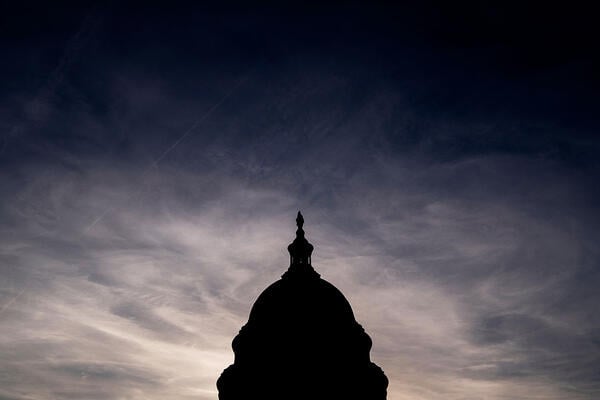
Researchers, Colleges Face Federal Shutdown Impacts
The U.S. government has been without a spending plan for two weeks now. Senate Democrats aren’t backing down on their demands that Republicans extend health insurance subsidies and reverse Medicaid funding cuts, and Senate Republicans continue to push a short-term funding bill that would reopen the government but not restore that funding. House Republicans aren’t even in Washington to help work out a compromise.
Few congressional watchers in D.C. think the shutdown, now in its 14th day, will end anytime soon. So far, the funding lapse has meant furloughs for thousands of federal workers, layoffs at eight agencies and shuttering of government buildings. Historically, shutdowns have a muted immediate impact, but a few higher ed experts warned that the longer they persist, the more disruptive they become.
Some higher ed and research associations as well as universities and researchers say the continued shutdown is harming budgets and discoveries after the already tumultuous first nine months of the second Trump administration. The government closure means that, after this presidency’s mass grant cancellations and slowdowns in new awards due to political reviews, the new federal fiscal year that began Oct. 1 has only brought even more uncertainty about the future of federally funded research.
At the start of this month, the National Institutes of Health, a major funder of university research, issued written guidance saying that researchers “may be able to continue drawing funds from prior awards during an appropriations lapse.” But there were caveats. The agency told researchers that, if their grants had “restrictive terms and conditions,” or if their drawdowns triggered “one of the Payment Management System edit checks and/or the drawdown limit controls,” they might not be able to access the money.
The NIH said its “extramural employees will be prohibited from working” and won’t have access to emails, nor will they be updating websites. The agency said researchers should still submit grant applications by the previously set deadlines, but those applications wouldn’t be processed until operations resumed. Grant peer-review panel meetings are also postponed.
“With the exception of excepted programs, no NIH grant awards will be processed for the duration of the funding lapse,” the guidance says.
The National Science Foundation, another major research funder, shared similar guidance as the shutdown began, saying, “NSF may not be available to respond to emails or phone calls during a lapse in appropriations” and “no new grants or cooperative agreements will be awarded.”
Universities can foot the bill to continue research that federal funding has paused—but only for so long. The picture of what’s happened so far is mixed.
At Ohio State University, a spokesperson wrote in an email to Inside Higher Ed on Monday that “there have been minimal disruptions, research work continues, and Pell Grants, federal loans and loan repayment systems remain operational.”
But the Georgia Institute of Technology released a statement Monday saying, “Payment from sponsors has been delayed,” and if the shutdown continues beyond another week, the university is “prepared to significantly limit” consulting services, job offers, “significant non-personnel” expenses and “non-essential” travel. The university said the “impasse is delaying payment for federally funded research activities at Georgia Tech, which represent more than $100 million per month in expenses.”
“While we remain hopeful that the U.S. government shutdown will end soon, it is a fluid situation, and we need to begin to slow spending to preserve cash and maintain essential campus operations,” said Kim Toatley, Georgia Tech’s chief financial officer, in the statement.
At the University of Maryland at College Park, cell biology and molecular genetics professor Anne Simon said she and others were awarded an Agriculture Department grant in December 2024 to modify and test viruses that can fight plant diseases including citrus greening, which destroyed more than 90 percent of Florida’s orange production. But Simon said the money was delayed. And then, just as her university provided the federal government the final requirement to move forward—a letter saying it would comply with an anti–diversity, equity and inclusion executive order—the government shut down, she said.
“We desperately need this money, and we desperately need to get started on this research and it’s delayed again and so it’s very difficult,” Simon said.
Other researchers say their and their colleagues’ and students’ work is being disrupted by the shutdown as it prevents collaboration with federal employees at agencies such as the National Oceanic and Atmospheric Administration. In all, the shutdown is further stymieing an already stymied U.S. research ecosystem. Research associations say things will only get worse.
No Forward Progress
Travis York, director of the Center for STEMM Education & Workforce at the American Association for the Advancement of Science, told Inside Higher Ed that “each additional week without full federal operations compounds” problems. York said very large universities are often more able to weather short disruptions, but less-resourced ones will be impacted more quickly.
He also noted that new grant funds aren’t being awarded, and proposed grants aren’t even being reviewed. And program officers at federal agencies aren’t available to answer questions.
“The longer the shutdown happens, the worse the impact of those things are,” he said.
Matt Owens, president of COGR—an organization that only goes by its acronym and that advocates for researchers and universities on the federal level—said in an email that his organization hasn’t received reports of specific impacts to research projects, but it is continuing to monitor the situation.
“What is clear about federal government shutdowns: the longer they last, the more negative impacts emerge and grow,” Owens wrote.
Elena Fuentes-Afflick, chief scientific officer for the Association of American Medical Colleges, said every extra day of the shutdown matters. And she said even this amount of delay “could cause disruptions in the future.”
“Inquiries are not being answered, submissions are not being confirmed and there’s nothing in terms of new funding opportunities,” Fuentes-Afflick said, adding that “forward progress is not happening.”
“Everything is on hold,” she said.
Debbie Altenburg, vice president for research policy and advocacy at the Association of Public and Land-grant Universities, said some universities are having to figure out how to temporarily fund graduate fellowships while the federal government isn’t. She said that’s just one of the problems institutions face.
“I don’t think we’ve reached that critical stage where many campuses have had to make difficult decisions, but they’re planning for that potential,” Altenburg said.
York further stressed that shutdowns discourage future collaborations with federal researchers and hurt the credibility of the U.S. as a reliable research partner internationally. He also said that the longer a shutdown lasts, the greater the risk of a permanent talent drain from U.S. science.
“We have to remember that federal funding helps multiple organizations create these career-connected pathways into and through STEM,” he said.
“Shutdowns are not simply a fiscal event—they’re also signals,” he added. “So when the government halts, it tells young scientists and scholars that their work is conditional.”
Source link


